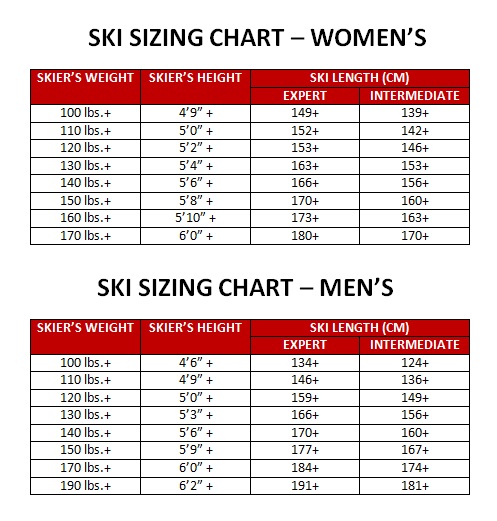Unlocking the Slopes: Choosing the Right Ski Length
Carving down a snowy mountain, wind whipping past, is an exhilarating experience. But the joy of skiing is heavily dependent on having the right equipment. One of the most critical choices you’ll make is determining the correct ski length. Choosing the right size skis can be the difference between a smooth, controlled descent and a frustrating, tiring battle against your gear.
Navigating the world of ski lengths can feel overwhelming. From beginner-friendly shorter skis to expert-level longer skis, the options seem endless. This guide aims to demystify the process of selecting the perfect ski length for your needs, helping you unlock your full potential on the slopes.
So, how do you figure out what ski length is right for you? There's no single magic formula, but a combination of factors plays a role. Your height, weight, skiing ability, and preferred skiing style all contribute to the ideal ski length. Ignoring these factors can lead to instability, difficulty controlling your skis, and a less enjoyable experience overall.
Historically, skis were much longer than they are today. Think long, straight wooden planks. As technology advanced, ski designs evolved, becoming shorter, lighter, and more shaped, allowing for greater maneuverability and control. This shift means that the "old rules" about ski length no longer apply. Modern ski design takes into account factors beyond just height, allowing for personalized ski selection.
Understanding how ski length influences performance is crucial. Longer skis generally provide more stability at higher speeds and on steeper slopes. They also tend to have a larger surface area, offering better float in powder snow. Shorter skis, on the other hand, are more agile and easier to turn, making them ideal for beginners and those who prefer skiing groomed runs.
Simply put, the appropriate ski length is the size that allows you to maintain control and enjoy your time on the mountain. It's about finding the sweet spot where stability and maneuverability intersect.
One benefit of choosing the right ski length is improved control. Skis that are too long can be difficult to maneuver, especially at slower speeds or in tight turns. Conversely, skis that are too short can feel unstable at higher speeds or on uneven terrain.
Another advantage is enhanced performance. The right ski length allows you to ski more efficiently, using less energy and achieving better results. You'll be able to carve smoother turns, maintain better balance, and enjoy a more dynamic skiing experience.
Finally, appropriate ski length contributes significantly to increased comfort and enjoyment. When your skis are the right size, you'll feel more confident and in control, allowing you to relax and truly appreciate the thrill of skiing.
A simple step-by-step guide to determining suitable ski length involves considering your height, weight, and skill level. Begin by finding a chart that correlates these factors to a recommended ski length range. Then, within that range, consider your skiing style. If you prioritize carving and high-speed descents, lean towards the longer end of the range. If you prefer quick turns and maneuverability, choose a shorter length.
Advantages and Disadvantages of Different Ski Lengths
| Ski Length | Advantages | Disadvantages |
|---|---|---|
| Shorter | Easier to turn, better for beginners, more agile | Less stable at high speeds, less float in powder |
| Longer | More stable at high speeds, better float in powder | Harder to turn, requires more skill |
One best practice is to demo different ski lengths before making a purchase. This allows you to experience how various sizes perform on the snow and find the perfect fit. Talking to a ski shop expert is also invaluable. They can assess your needs and provide personalized recommendations.
A common challenge is feeling unsure about which length to choose within the recommended range. The solution is to consider your preferred skiing style and terrain. Do you primarily ski groomed runs or venture into powder? Thinking about these factors can help you narrow down the ideal length.
Frequently Asked Questions:
1. How do I know what length skis I should get?
Consider your height, weight, skill level and skiing style. Consult a ski length chart and talk to a ski shop expert.
2. Are shorter skis better for beginners?
Generally, yes. Shorter skis are easier to maneuver and control, which is beneficial for those learning to ski.
3. What are the advantages of longer skis?
Longer skis provide more stability at higher speeds and better float in powder snow.
In conclusion, determining the right ski length is a crucial step in maximizing your skiing experience. By considering your height, weight, skill level, and skiing style, you can find the perfect skis to unlock your full potential on the slopes. While it can seem complex, the process is manageable with the right information and guidance. Taking the time to choose the right skis will lead to greater control, improved performance, and ultimately, a more enjoyable time on the mountain. So, before your next ski trip, invest the time to find your perfect pair – you won't regret it.
Unlocking value your guide to the used chevy 30 duramax
Navigating the open road and water xtreme boat and rv adventures
Upgrade your screen the ultimate guide to pink desktop wallpapers











